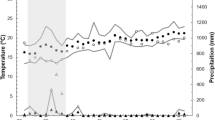Abstract
Foraging habitat selection of breeding great reed warblers was studied at a shore of Lake Biwa. The foraging grounds of parent warblers during the nesting period were not restricted to the breeding territory of the reed marsh, their nestling habitat. The paddy field outside the reed marsh was used communally by them throughout the breeding season. Females with early stage nestlings did not visit the paddy field whereas when nestlings were older than 3 days, more than half of their total food was collected there. Females with nests adjacent to the paddy field tended to exploit the paddy field more often than those with nests distant from it. Monogamously mated females tended to exploit the paddy field more often than polygynously mated females. Food collected in the paddy field was larger than that in the reed marsh and parent birds were prepared to travel longer distances to exploit the rich source of food in the paddy field. The importance of the communal foraging ground outside the reed marsh as a background of the polygynous mating system of this species is discussed.
Similar content being viewed by others
References
Ban Y. &Kiritani K. (1980) Seasonal prevalence of aquatic insects inhabiting paddy fields.Jpn. J. Ecol. 30: 393–400 (in Japanese with English summary).
Bernatowicz S. &Zachwieja J. (1966) Types of littoral found in the lakes of the Masurian and Suwalki Lakelands.Ecol. Pol. 14: 519–45.
Best L. B. (1977) Nestling biology of the field sparrow.Auk 94: 308–19.
Biermann G. C. &Sealy S. G. (1982) Parental feeding of nestling yellow warblers in relation to brood size and prey availability.Auk 99: 332–41.
Carlson A. (1983) Maximizing energy delivery to dependent young: a field experiment with red-backed shrikes (Lanius collurio).J. Anim. Ecol. 52: 697–704.
Carlson A. &Moreno J. (1981) Central place foraging in the wheatearOenanthe oenanthe: an experimental test.J. Anim. Ecol. 50: 917–24.
Crook J. H. (1964) The evolution of social organization and visual communication in the weaver birds (Ploceinae).Behaviour 10 (Suppl.): 1–178.
Dyrcz A. (1977) Polygamy and breeding success among great reed warblersAcrocephalus arundinaceus at Milicz, Poland.——Ibis119: 73–7.
Dyrcz A. (1986) Factors affecting facultative polygyny and breeding results in the great reed warbler (Acrocephalus arundinaceus).J. Orn. 127: 447–61.
Ezaki Y. (1981) Female behaviour and pair relation of the polygynous great reed warblerAcrocephalus arundinaceus (Aves: Sylviinae).Physiol. Ecol. Jpn 18: 77–91.
Ezaki Y. (1987) Male time budgets and recovery of singing rate after pairing in polygamous great reed warblers.Jpn. J. Orn. 36: 1–11.
Ezaki Y. (1988) Mate desertion by male great reed warblersAcrocephalus arundinaceus at the end of the breeding season.——Ibis130: 427–37.
Ezaki Y. (1990) Female choice and the causes and adaptiveness of polygyny in great reed warblers.J. Anim. Ecol. 59: 103–19.
Haneda K. &Teranishi K. (1968) Life history of the eastern great reed warbler (Acrocephalus arundinaceus orientalis) I. breeding biology.Jpn. J. Ecol. 18: 100–9 (in Japanese with English summary).
Hegner R. E. (1982) Cential place foraging in the white-fronted bee-eater.Anim. Behav. 30: 953–63.
Kobayashi T., Noguchi Y., Hiwada T., Kanayama K. &Maruoka N. (1973) Studies on the arthropod associations in paddy fields, with particular reference to insecticidal effect on them. I. General composition of the arthropod fauna in paddy fields revealed by net-sweeping in Tokushima Prefecture.Kontyu. Tokyo 41: 359–73 (in Japanese with English summary).
Kobayashi T., Noguchi Y., Hiwada T., Kanayama K. &Maruoka N. (1974) Studies on the arthropod associations in paddy fields, with particular reference to insecticidal effect on them. II. Seasonal fluctuation of species diversity and abundance in arthropod associations in paddy fields by net-sweeping in Tokushima Prefecture.Kontyu, Tokyo 42: 87–106 (in Japanese with English summary).
Krebs J. R. &Avery M. I. (1985) Central place foraging in the European bee-eater,Merops apiaster.J. Anim. Ecol. 54: 459–72.
Lack D. (1968)Ecological Adaptations for Breeding in Birds, 409 pp. Chapman & Hall, London.
Mizuta K. (1978) Ovipositing strategy inSympetrum species.Insectarium 15: 104–9 (in Japanese).
Orians G. H. (1961) The ecology of blackbird (Agelaius) social systems.Ecol. Monogr. 31: 285–312.
Orians G. H. (1966) Food of nestling yellow-headed blackbirds, Cariboo parklands, British Columbia.Condor 68: 321–37.
Orians G. H. (1969) On the evolution of mating systems in birds and mammals.Am. Nat. 103: 589–603.
Orians G. H. (1980)Some Adaptations of Marshnesting Blackhirds, 295 pp. Princeton University Press, Princeton.
Pinkowski B. C. (1978) Feeding of nestling and fledgling eastern bluebirds.Wilson Bull. 90: 84–98.
Sakurai Y. (1987) (Landscape of lake littoral and its ecological value.)Kokuritsu Koen 452: 2–11 (in Japanese).
Saitou T. (1976) Breeding biology of the eastern great reed warbler,Acrocephalus arundinaceus orientalis.Misc. Rep. Yamashina Inst. Orn. 8: 135–56.
Taguchi M. &Watanabe M. (1986) Ecological studies of dragonflies in paddy fields surrounded by hills. III. Population dynamics ofSympetrum frequens Selys.Bull. Fac. Educ. Mie Univ. 37: 69–75 (in Japanese).
Takamura K. &Yasuno M. (1986) Effects of pesticide application on chironomid larvae and ostracods in rice fields.Appl. Ent. Zool. 21: 370–6.
Urabe K., Ikemoto T., Takei S. &Aida C. (1986) Studies onSympetrum frequens (Odonata: Libelluidae) nymphs as natural enemies of the mosquito larvae,Anopheles sinensis, in rice fields. III. Estimation of the prey consumption rate in the rice fields.Jpn. J. Appl. Ent. Zool. 30: 129–35 (in Japanese with English summary).
Urano E. (1990) Factors affecting the cost of polygynous breeding for female great reed warblersAcrocephalus arundinaceus. Ibis 132: 584–94.
Waish H. (1978) Food of nestling purple martins.Wilson Bull. 90: 248–60.
Willson M. F. (1966) Brecding ecology of the yellow-headed blackbird.Ecol. Monogr. 36: 51–77.
Wilson S. W. (1978) Food size, food type, and foraging sites of red-winged blackbirds.Wilson Bull. 90: 511–20.
Yasukawa K. &Searcy W. A. (1981) Nesting asynchrony and dispersion in red-winged blackbirds: Is the harem competitive or cooperative?Auk 98: 659–68.
Author information
Authors and Affiliations
About this article
Cite this article
Ezaki, Y. Importance of communal foraging grounds outside the reed marsh for breeding great reed warblers. Ecol. Res. 7, 63–70 (1992). https://doi.org/10.1007/BF02348598
Accepted:
Issue Date:
DOI: https://doi.org/10.1007/BF02348598




